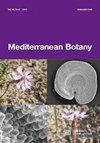Mechanical stimulation of the stigmas triggers switch from female to male phase in the protogynous trap flower of Aristolochia rotunda (Aristolochiaceae)
IF 0.7
4区 生物学
Q3 PLANT SCIENCES
引用次数: 0
Abstract
Floral longevity is a selected trait that shows plasticity, allowing plants to balance resource allocation and reproduction. In dichogamous flowers—in which female and male functions are decoupled in time—the duration of the female phase is expected to vary according to pollination status. We used Aristolochia rotunda as a model to test the hypothesis that the female phase should be shortened following pollen deposition on the stigma, and to identify the signal for phase switching. Aristolochia flowers are protogynous (female phase first) and trap pollinators for several days (trap flowers). The four experimental treatments we applied to flowers, i.e. hand pollination, presence of pollinators with or without pollen load in the flower, and deposition of a nylon thread on the stigma, shortened the female phase to a similar extent, demonstrating that the duration of the female phase depended on the presence of pollinators, independently of whether or not they carried pollen, and that mechanical stimulation of the stigmas was the signal for phase switching. Temperature was also shown to shorten the female stage. This mechanism of post-anthesis floral changes is original because usually such changes are triggered by chemical interactions between pollen and stigmas. We interpret the mechanical signal used in A. rotunda for phase switching to be adaptive when pollinators are limiting, because switching to the male phase even if the trapped pollinator does not bring pollen would ensure fulfilling the flower’s male function.机械刺激圆形马兜铃花柱头触发雌花向雄花的转变
花的寿命是一种选择特性,显示出可塑性,使植物能够平衡资源分配和繁殖。在雌雄同花中——雌花和雄花的功能在时间上是分离的——雌花阶段的持续时间预计会根据授粉状态而变化。本研究以圆形马兜铃(Aristolochia rotunda)为研究对象,验证花粉在柱头上沉积后雌蕊期缩短的假设,并确定其相位转换的信号。马兜铃花是雌雄同体的(雌花先行),可以诱捕传粉者数天(诱捕花)。我们对花进行的四种实验处理,即手授粉、传粉者携带花粉或不携带花粉,以及在柱头上沉积尼龙线,都在类似程度上缩短了雌花期,这表明雌花期的持续时间取决于传粉者的存在,而与他们是否携带花粉无关,柱头的机械刺激是相位转换的信号。温度也会缩短雌性的发育阶段。这种花后花的变化机制是原始的,因为这种变化通常是由花粉和柱头之间的化学相互作用触发的。我们认为,在传粉者数量有限的情况下,圆花莲的相位转换是自适应的,因为即使被困的传粉者没有带来花粉,圆花莲的相位转换也能保证花的雄性功能。
本文章由计算机程序翻译,如有差异,请以英文原文为准。
求助全文
约1分钟内获得全文
求助全文
来源期刊

Mediterranean Botany
Agricultural and Biological Sciences-Plant Science
CiteScore
2.40
自引率
10.00%
发文量
30
审稿时长
12 weeks
期刊介绍:
Mediterranean Botany (ISSNe 2603-9109), formerly Lazaroa, is a biannual journal that publishes original research studies in the field of Botany including plant systematics, vegetation ecology, biogeography, evolutionary biology, ecophysiology, community ecology, ethnobotany and conservation biology on Mediterranean biomes but also in interacting areas.
Mediterranean Botany is an OPEN ACCESS Journal, free of charges for any published article.
 求助内容:
求助内容: 应助结果提醒方式:
应助结果提醒方式:


